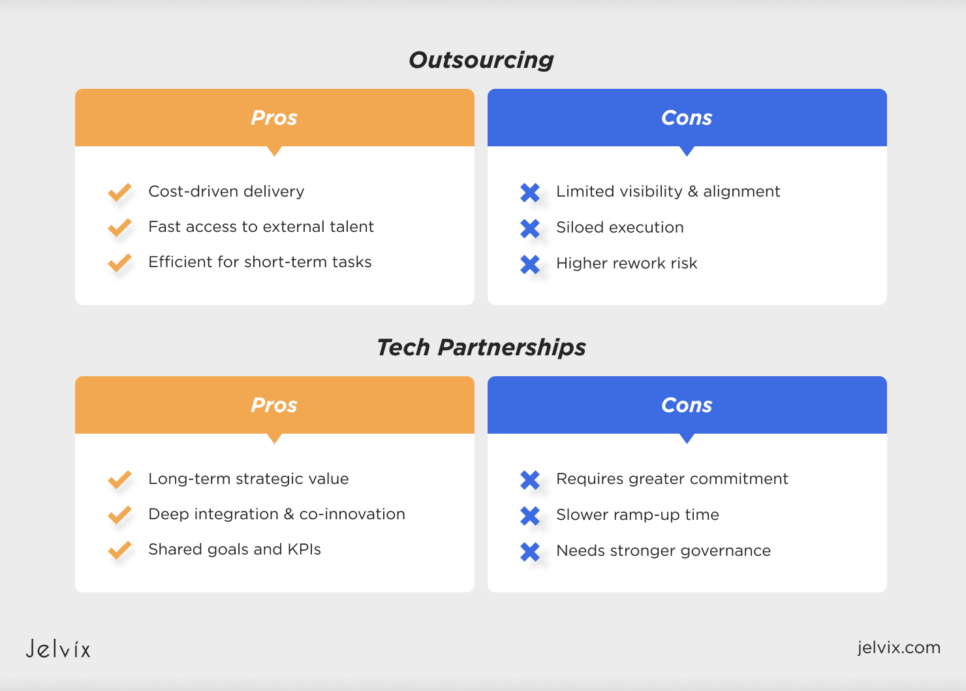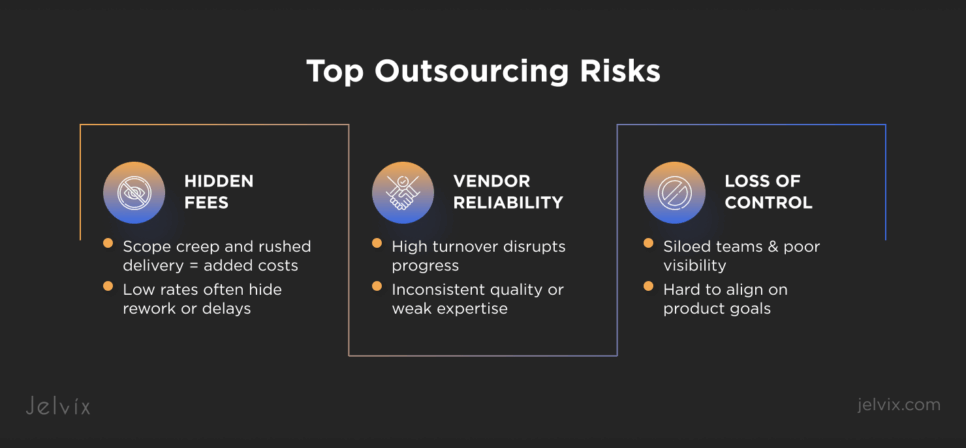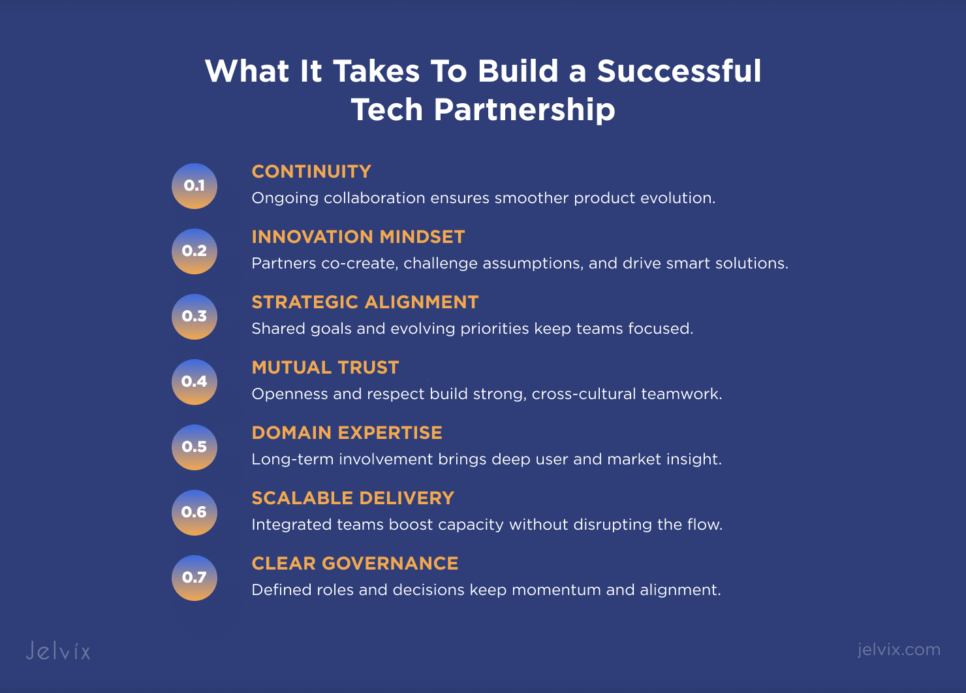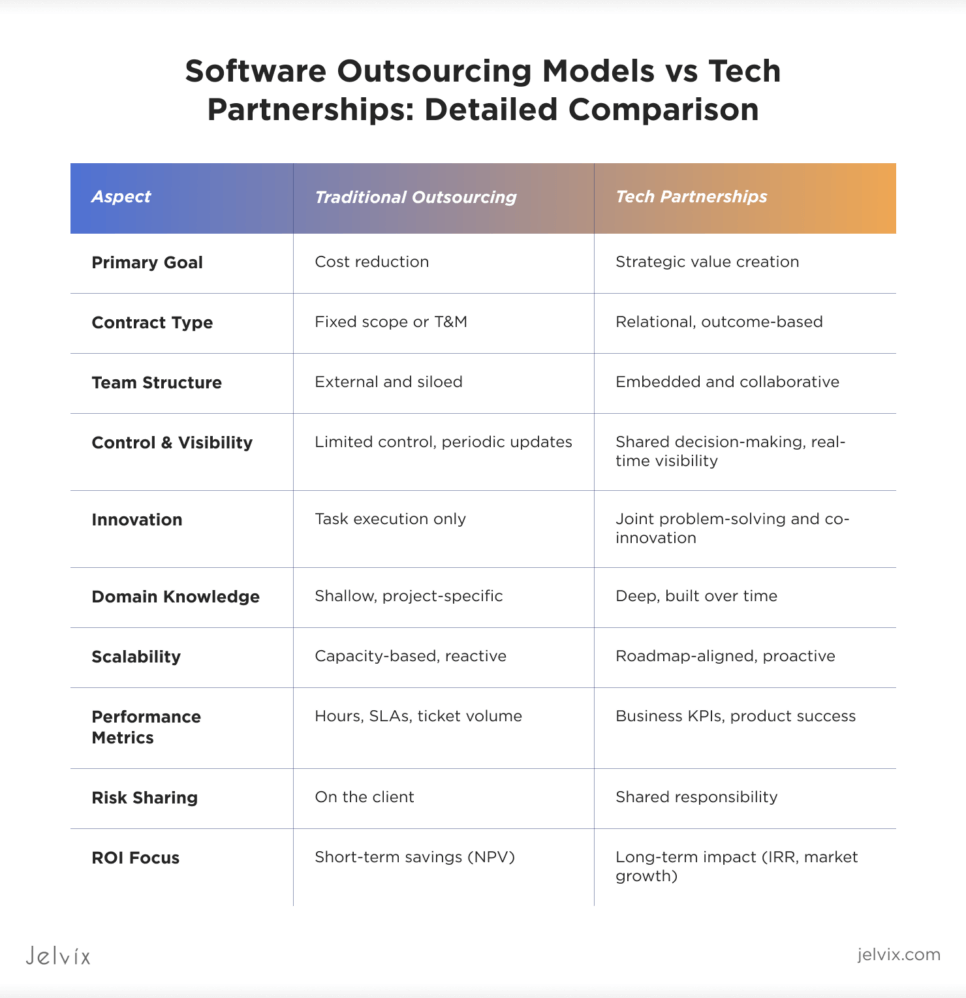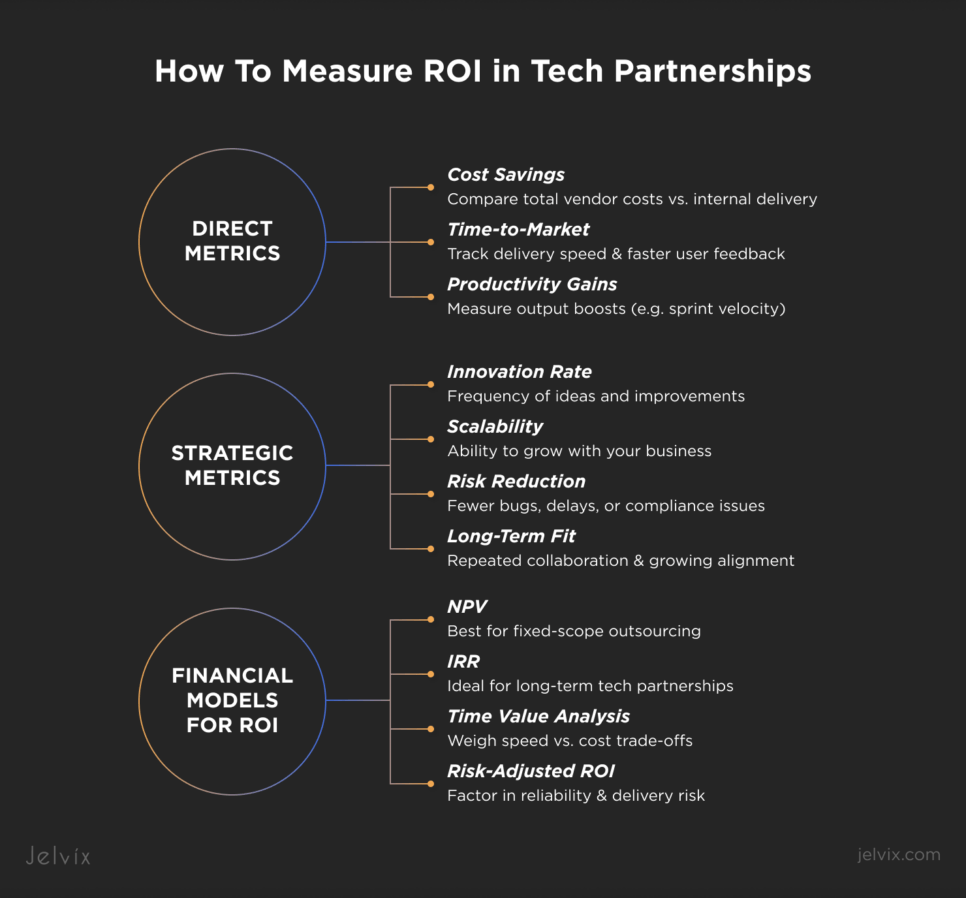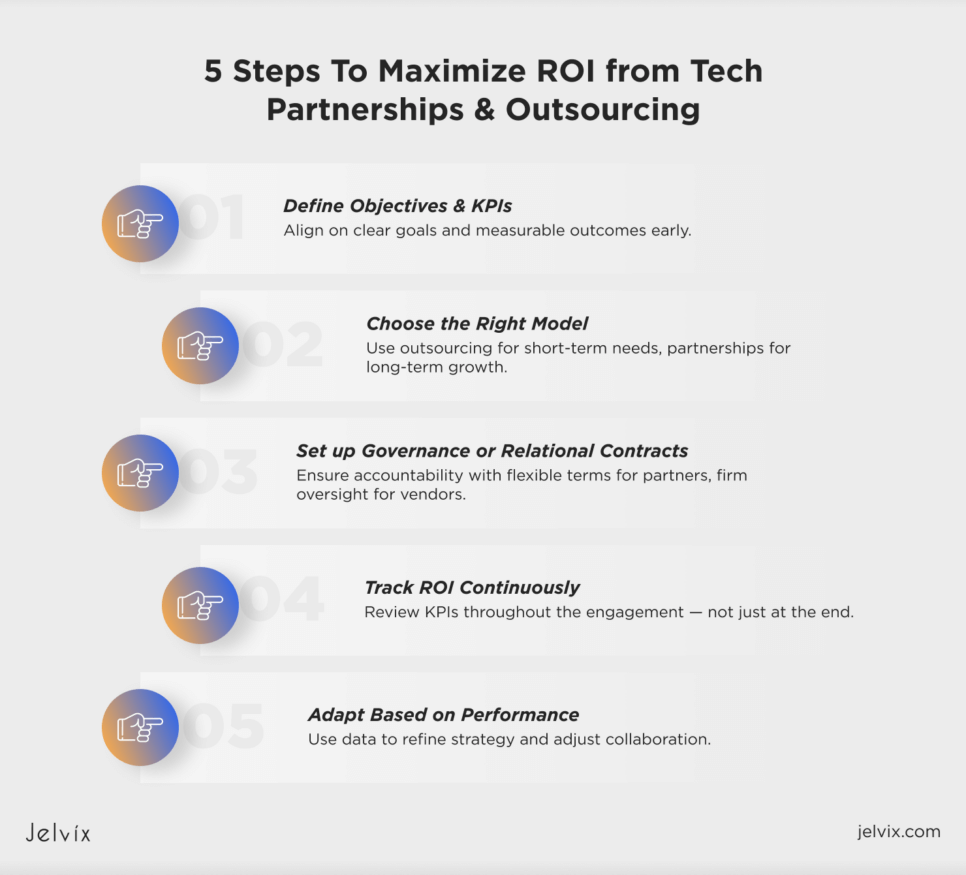Outsourcing still dominates talent strategies, but its role is changing. Although about 80% of companies plan to maintain their outsourcing budgets, 70% move previously outsourced work back in‑house.
Many C-levels struggle with choosing between outsourcing business services or building a long-term technology partnership. This article breaks down what drives ROI across both.
If you’re unsure which model fits your goals, keep reading. You’ll learn how to calculate the ROI of outsourcing and tech leadership partnerships, enabling you to support broader digital transformation solutions.
Understanding IT Outsourcing
Outsourcing means delegating specific business functions, operations, or development tasks to external service providers. The goal of software projects outsourcing is typically to reduce costs, access specialized expertise, or increase delivery speed.
Common Outsourcing Models
Outsourcing SaaS application development comes in different forms, and understanding the most common models can help you choose the right approach based on scope, timeline, budget, and the level of control you need.
Project-Based Outsourcing
A vendor is contracted to deliver a defined scope of work, often with fixed timelines and budgets. It’s best for short-term or low-risk projects, but it is limited in flexibility. Re-scoping can be costly and slow.
Dedicated Development Teams
Also known as IT staff augmentation, this model involves hiring external developers who integrate with your in-house team. It offers more control and flexibility than fixed-scope contracts but often lacks strategic alignment or shared product ownership.
Managed IT Services
A third-party provider is fully responsible for a specific function, like cloud infrastructure, QA, or support. It’s outcome-driven and governed by SLAs, but innovation and customization are usually limited.
Offshore, Nearshore, and Onshore Outsourcing
These terms refer to the geographic location of your vendor.
Offshore outsourcing offers the lowest cost, but it can result in potential challenges related to time zones and communication. Nearshore includes a better time zone and cultural business IT alignment, and is moderately priced. Onshore outsourcing involves the highest cost, but often results in maximum alignment and ease of collaboration.
Time and Materials
T&M outsourcing means that you pay for actual hours worked and materials used. Great for evolving requirements and flexibility, but harder to forecast ROI without strict project controls.
Common Tech Partnership Models
There are several types of technology partnerships designed to support SaaS and AI software development. Understanding these models helps select the optimal structure for long-term collaboration and strategic alignment.
Technology Alliances
Companies combine technologies or services to deliver joint solutions, often with shared roadmaps and go-to-market plans.
Joint Ventures
Two or more companies collaborate to create a new entity to develop and launch a product. Ownership, risk, and reward are shared.
Product Co-Development
Teams work together on a single product, often sharing IP and responsibilities. This enables faster delivery and stronger outcomes.
Platform and Ecosystem Integrations
Fintech, insurance, and healthcare technology partners of this type focus on embedding products into broader systems to create seamless and scalable experiences.
Innovation Labs or R&D Partnerships
Focused on prototyping and testing new ideas. These long-term collaborations reduce risk and bring emerging tech to life faster.
ROI Matrix: Important Considerations
Evaluating tech partnership or outsourcing cost for developing custom enterprise software requires understanding how well the model supports long-term goals, product performance, and adaptability.
Cost vs Quality
Outsourcing lowers upfront costs but may sacrifice quality and lead to rework. Tech partnerships cost more initially but deliver stronger returns through better planning and execution. While outsourcing buys capacity, partnerships build capability.
Productivity KPIs
Outsourcing tracks effort (hours, tickets, SLAs). Tech partnerships focus on outcomes like time-to-market, customer retention, and release speed, shifting from volume to value.
NPV vs IRR
Outsourcing uses the Net Present Value method that reflects immediate financial savings. Tech partnerships align with Internal Rate of Return models, capturing long-term value through faster growth and continuous innovation.
Top Outsourcing Risks for Businesses
Both outsourcing and tech partnerships come with operational and strategic risks. The difference lies in visibility, control, and long-term alignment.
Hidden Fees
Fixed-price contracts and low hourly rates can mask the actual app development cost. Scope changes, rushed timelines, or poor initial planning often lead to additional fees, delays, or quality issues.
Vendor Management and Reliability
Success depends on vendor stability, talent retention, and technical depth. High turnover or inconsistent quality can hinder progress and damage a reputation.
Loss of Control
Weak integration leads to siloed teams, misaligned goals, and limited visibility into development, reducing your ability to steer product direction.
Exploring the Possibilities of Technology Partnership
Tech partnerships are not transactional. They focus on long-term goals, shared accountability, and business impact, with both sides working together to create value.
Unlike traditional outsourcing, these partnerships rely on relational contracts, which prioritize collaboration, flexibility, and joint problem-solving instead of rigid scopes and fixed timelines.
Advantages of Innovation Partnerships
Tech partnerships create long-term value by embedding external teams into your business strategy, culture, and growth goals.
Continuity
Partners stay involved through every stage of development. This reduces onboarding, preserves context, and ensures smoother product evolution.
Innovation
With shared goals, partners contribute ideas and challenge assumptions, driving faster and smarter innovation.
Deep Domain Understanding
Over time, partners gain insight into your market and users, resulting in more relevant and tailored solutions.
Faster Scaling
Integrated teams bring additional capacity while aligning with your delivery standards and engineering culture.
Explore proven strategies to scale your IT infrastructure efficiently, support business growth, and maintain performance under increasing demand.
Strategic Flexibility
As business needs shift, strong partners adapt, avoiding the delays of rigid contracts or vendor swaps.
Challenges of Hiring a Technology Alliance Partner
While tech partnerships offer long-term value, they also demand a higher level of commitment, clarity, and coordination.
Strategic Alignment
Partnerships are most effective when both parties align on goals, priorities, and success metrics. This requires upfront clarity and ongoing communication as the business evolves.
Building Trust
Partnerships rely on transparency and mutual respect. Trust takes time to build, especially across different cultures or working styles, but it’s essential for smooth collaboration.
Partnership Governance
Clear roles, responsibilities, and decision-making paths keep teams coordinated. Without strong governance, even capable teams can lose focus and speed.
Software Outsourcing Models vs Tech Partnerships: Detailed Comparison
Before choosing a vendor or signing a new contract, ensure you see the whole picture. Jelvix experts created this side-by-side comparison to help decision-makers evaluate delivery models based on long-term impact.
As shown in the table, outsourcing delivers capacity, but tech partnerships deliver capability. If the goal is short-term execution, outsourcing may suffice. But if you’re aiming for sustained growth and long-term ROI, a tech partnership can create far greater leverage.
Measuring ROI and Evaluating Strategic Partnership KPIs
Not all values show up in a spreadsheet. To assess whether a vendor relationship or tech partnership truly delivers, you need to track both direct and strategic digital transformation metrics and choose financial models that reflect long-term impact.
Discover how blockchain drives business ROI by enhancing security, streamlining operations, and enabling scalable growth through trusted digital infrastructure.
Direct Metrics
Direct ROI metrics focus on measurable improvements in cost, speed, and efficiency. They help assess the immediate impact of an outsourcing or tech partnership decision.
Cost Savings
Track the total cost of external collaboration compared to internal delivery. Include not just hourly rates, but also onboarding time, project delays, and quality-related rework.
Time-to-Market
Track how fast new features or products reach users. Faster delivery means quicker feedback, earlier revenue, and a market advantage.
Productivity Gains
Measure output improvements like sprint velocity or backlog reduction. A well-integrated partner frees up your internal team to focus on high-value work.
Indirect and Strategic Metrics
Beyond immediate cost savings, real ROI comes from long-term impact.
Innovation Rate
Track how often the partner brings new ideas or improvements. High innovation shows they’re actively contributing, not just executing.
Scalability
Assess how well the team adapts to growth, technically, operationally, and strategically. Scalable partners keep you moving without delays.
Risk Reduction
Look at how the partner helps avoid issues: better code, stronger QA, compliance, and stability all reduce costly setbacks.
Long-Term Fit
Track repeated collaboration, growing responsibilities, and alignment with your goals. Strong partnerships reduce churn and keep momentum.
How to Calculate Digital Transformation ROI Correctly?
Raw performance metrics matter, but decision-makers need financial models that reflect real business impact. These models help compare different sourcing options and justify your digital transformation investment.
Net Present Value
NPV shows whether an investment generates more value than it costs, accounting for time. It’s ideal for fixed-scope outsourcing projects.
Internal Rate of Return
IRR measures long-term return potential. It’s best for tech partnerships that deliver value through speed, quality, and ongoing growth.
Time Value Analysis
Use time value analysis to factor in the opportunity cost of delays. For example, a faster go-to-market can generate earlier revenue, even if the vendor cost is higher.
Risk-Adjusted ROI
Adjust ROI calculations by factoring in the risk of delays, rework, or failure. A higher-cost partner with strong reliability may outperform a cheaper alternative that introduces risk.
When To Outsource vs Go with Software Partnership
Choosing between software projects outsourcing and a tech partnership depends on your goals, timeline, and how critical the work is to your long-term success. Each model serves a purpose, and the key is knowing when to use which.
When To Outsource
Outsourcing works best when the priority is short-term execution or cost optimization. Use it when you need:
- Bolt-on expertise for a specific technology or task
- Extra capacity during a peak delivery cycle
- Cost arbitrage for clearly defined, low-risk projects
- Quick delivery with minimal internal coordination
This model suits non-core functions or clearly scoped work that doesn’t require deep integration with your team or strategy.
When to Consider Technology Alliances
Choose a tech partnership when the work ties directly to your core product, business model, or growth roadmap. Find a tech partner if you need:
- Continuity across multiple releases or product stages
- Innovation from a team that challenges assumptions and contributes ideas
- Shared goals around product success, not just task completion
- Alignment with long-term growth and the flexibility to scale with you
This model is suitable for strategic initiatives where product quality, market timing, and long-term collaboration are more important than short-term cost savings.
Real-World Examples of Successful Tech Partnerships
Understanding the theory is one thing. Seeing how it plays out in practice brings the ROI difference into focus..
Healthcare: Remote Patient Monitoring Partnership
According to ResearchGate, a large urban healthcare system reported an average ROI of 22.2% from remote hypertension monitoring programs, with ROI ranging from –11.1% to +93.3% depending on the cost structure. These gains result from deep integration between clinical teams and tech partners who co-designed workflows, data integration, and compliance.
Fintech: AI-Driven Fraud Detection
A case involving a Google-HSBC co-development saw 60% fewer false positives and faster processing, thanks to shared innovation of a Dynamic Risk Assessment platform. These results stem from partnerships that enabled joint algorithm tuning, shared roadmaps, and continuous model refinement.
eCommerce: Personalization via Tech Partnerships
According to McKinsey, 70% of retailers that invested in personalization reported returns of at least 400% ROI. AI-driven personalization further boosted revenue by around 15% and increased marketing ROI by 10–30%. These gains come from close tech partnerships that embed into product teams to build recommendation engines, dynamic content, and real-time analytics.
Common Mistakes to Avoid when Working with Tech Partners
Even strong sourcing strategies can fail without the right foundations. You need to be aware of the common mistakes companies make when working with external teams.
Switching Vendors Mid-Project
Frequent vendor changes disrupt continuity, slow down delivery, and create knowledge gaps. Most switches happen due to poor upfront due diligence or unclear expectations.
Lack of SLA Clarity
Vague or missing service level agreements lead to misaligned priorities, unmet deadlines, and blame cycles. Clear SLAs with measurable KPIs keep both sides accountable.
Cultural Mismatch
Differences in work style, communication pace, or decision-making processes can create friction. A poor cultural fit leads to slow collaboration, miscommunication, and reduced trust.
Key Steps To Maximize ROI with Strategic Outsourcing and Tech Partnership
Regardless of which model you choose, long-term value ultimately depends on how well you manage the relationship. These steps help you stay aligned, reduce friction, and turn external collaboration into a strategic advantage.
1. Clarify Objectives and Define KPIs
Start with a clear understanding of what success is. Align internal teams and external partners on specific goals, from delivery speed to innovation targets. Define measurable KPIs early and tie them to business outcomes, not just tasks.
2. Choose the Right Engagement Model
Match the model to the problem. Use outsourcing for execution-heavy, time-bound projects. Use partnerships for complex, evolving initiatives that need shared ownership and long-term alignment.
3. Build Relational Contracts or Strong Vendor Governance
If you’re partnering, use relational contracts that support flexibility, joint problem-solving, and shared risk. If you’re outsourcing, establish clear governance structures to manage performance, resolve issues promptly, and maintain project continuity.
4. Track ROI Regularly and Review Performance
Don’t wait for project closeout to measure impact. Review KPIs at regular intervals. Consider both short-term delivery and long-term contributions to business goals. Course-correct early to stay aligned.
5. Adjust Strategy Based on Learnings
Use performance data to refine your collaboration approach. Shift models, reallocate resources, or deepen engagement as needed. The best results come from treating external collaboration as a living strategy, not a fixed contract.
Conclusion: Why ROI Is Not Just About Cost
The most successful companies don’t just outsource to save money. They build relationships that deliver speed, innovation, and long-term value. Consequently, ROI today means not just cutting budgets, but building systems, relationships, and capabilities that compound over time.
If you’re unsure which model best fits your goals, contact us. Our experts can help you explore how a custom-built engagement supports your growth strategy and delivers measurable results.
FAQ
What’s the key difference between outsourcing and tech partnerships?
Outsourcing focuses on task execution and short-term delivery. Tech partnerships focus on shared goals, innovation, and long-term product success. Partnerships offer deeper integration and strategic alignment across teams.
Which delivers better ROI: outsourcing or tech partnerships?
Tech partnerships often deliver better long-term ROI by improving innovation, scalability, and product quality. Outsourcing may reduce short-term costs, but it rarely supports sustained growth or adaptability.
How to measure digital transformation progress and outsourcing ROI?
Track direct metrics like cost savings, time-to-market, and productivity. Use NPV for short-term projects and IRR for long-term value. Include risk adjustment and time value analysis for accurate impact.
When to choose a tech partnership instead of outsourcing?
Choose tech partnerships when continuity, co-innovation, and strategic alignment are critical. This is ideal for core products, evolving platforms, and high-growth initiatives that need shared ownership.
What common mistakes should businesses avoid in IT outsourcing?
Avoid unclear SLAs, poor vendor fit, cultural mismatch, and switching vendors mid-project. These lead to delays, hidden costs, and reduced trust, damaging project outcomes and team performance.
Need a reliable tech partner?
Accelerate your business growth with a dedicated development team aligned to your long-term goals.

